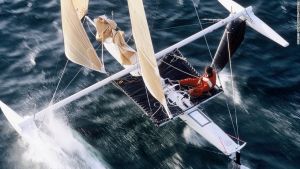Design influences, about L'Hydroptere
Center hull and cross beam (vaka and aka)
Outer hulls (amas)
Main foils
Rudders, T-foil and daggerboard
Rigging and sails
Maybe you've heard of L'Hydroptere, a French foiling trimaran sailboat that's gone 56 knots (64 mph). The most recent 74 ft. long version evolved from a series of prototypes dating back to 1976. I like this boat. Like many sailing enthusiasts, I want to foil too. There are foiling sailboats that you can buy like the Hobie Trifoiler and the Windrider Rave, and there's a popular class of small foiling boats called Moths. I live on a bay that can be a shallow much of the time. Besides the Moth being a challenging, crash-prone, wet boat boat to sail, its long t-foils wouldn't work well in shallow water. Trifoilers and Raves aren't made anymore, and I simply wanted to build my own boat. So, I modeled mine after the second Hydroptere prototype, which is about the same size as beach cat.
This design uses surface piercing foils for most of its lift, with a t-foil rudder. The main foils attach to the ends of the cross beam (aka) and are angled down at 45 degrees when deployed. The faster the boat goes, the higher out of the water it gets. The "real" Hydroptere's t-foil may have moveable control surfaces (I don't know), but I'm pretty sure the 90s prototype didn't. Moving parts for controlling t-foils are complicated to design and fabricate and can be fragile. So I like surface piercing foils. Foil boats have become common (America's Cup, Moths, UFO foiler). Unlike AC boats, L'Hydroptere is unique in its seaworthiness. It sailed from Los Angeles to Hawaii!
Anyway, I tried to copy L'Hydropter's 90s era prototype based on measurements and proportions I got from information and photos found on the web.

The 90s Hydroptere prototype.
In a nutshell I was successful with this version. It foiled the first time I took it out! Truly amazing! However the low volume center hull (vaka) made it so the foils and other bits dragged in the water when it was in non-foiling mode. As such, I rebuilt the whole thing with a higher volume aka. You can learn about it here. However many things from this first version were used on the second version.